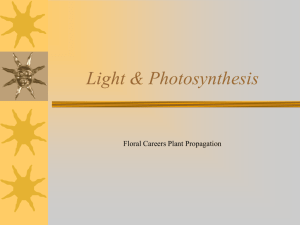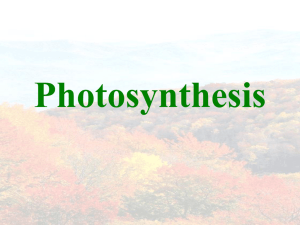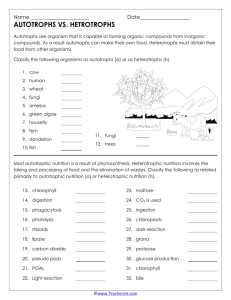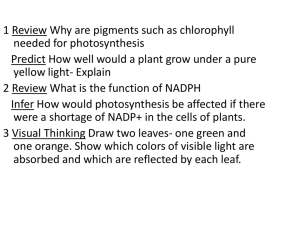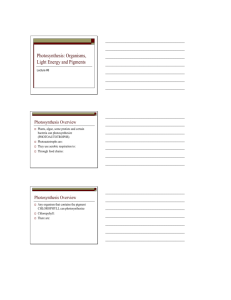Photosynthesis slideshow
advertisement
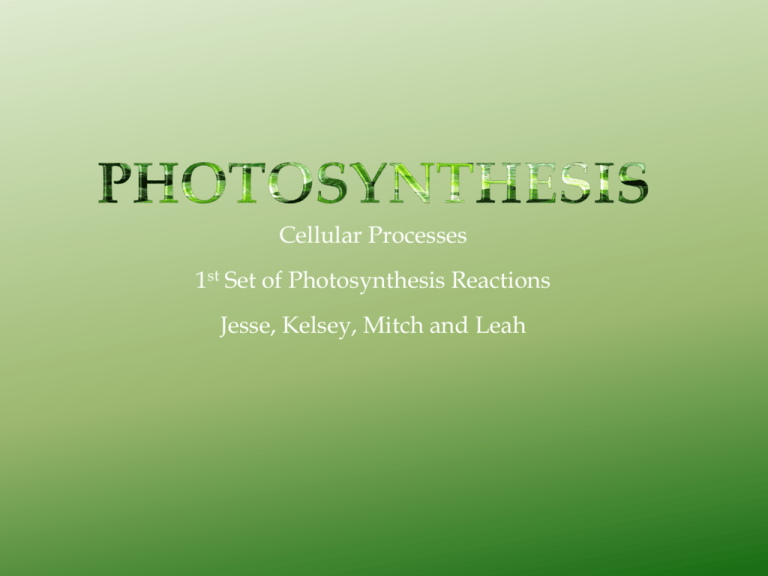
Cellular Processes 1st Set of Photosynthesis Reactions Jesse, Kelsey, Mitch and Leah AUTOTROPHS – Organisms that manufacture their own food from inorganic substances and energy HETEROTROPHS – Organisms, like animals, that cannot manufacture their own organic compounds BIOCHEMICAL PATHWAY – A series of reactions linked CELLULAR RESPIRATIONSome energy that is released from organic compounds is released by cells in another set of biochemical pathways. Autotrophs convert energy to light from the sun into chemical energy which they primarily store in carbohydrates. Heterotrophs obtain food by eating Autotrophs or other heterotrophs that feed on autotrophs. Autotrophs use the biochemical pathways to manufacture organic compounds from Carbon dioxide and water to create a carbohydrate and molecular oxygen is released Cellular respiration is a metabolic process by which cells generate energy in the form of ATP from the food molecules and release waste products carbon dioxide and water. Both Heterotrophs and Autotrophs use Cellular Respiration Light reactions – The initial reaction in photosynthesis ( In plants ) Thylakoids – Inside the inner membranes, arranged as flattened sacs Grana – thylakoids interconnected and some are layered on top of one another to form stacks Stroma – solution surrounding thylakoids Light reactions is the first stage of photosynthesis , the process by which plants capture and store energy from sunlight. Thylakoids are a membrane-bound compartment inside chloroplasts and cyanobacteria. They are the site of the lightdependent reactions of photosynthesis. Properties of light: the light from the sun appears white but is actually composed of a variety of colours known as the visible spectrum Light travels through space as waves of energy. Waves are measured in wavelength, the distance between crests in a wave. Pigment – a compound that absorbs light - When a white lights reflects off an object different colours will be bounced off, However the various colours will react differently if the object contains a pigment - Pigments absorb certain colours more strongly than others - By absorbing certain colours, a pigment subtracts those colours from the Visible spectrum - Colour transmitted by the pigment no longer appears white but rather the light wave that is being reflected Located in the membrane of the thylakoids are a variety of pigments, the most important of which are called Chlorophylls - Chlorophyll a - specific form of chlorophyll used in oxygenic photosynthesis. It absorbs most energy from wavelengths of violet-blue and orange-red light - Chlorophyll b - Chlorophyll b helps in photosynthesis by absorbing light energy. It is more soluble than chlorophyll a in polar solvents because of its carbonyl group. - Its color is yellow, and it primarily absorbs blue light. - Called an accessory pigment because it assists Chlorophyll a in capturing light energy Other compounds found in the thylakoid membrane, include the Yellow, Orange, and Brown carotenoids, also function as accessory pigments. - By absorbing the accessory pigments enable plants to capture more of the energy in light - During the fall many plants lose their chloroplasts and their leaves take on the rich hues of the carotenoids http://en.wikipedia.org/wiki/Chlorophyll_b http://www.ftexploring.com/photosyn/chloroplast.html#CHLOROPLA ST http://en.wikipedia.org/wiki/Thylakoid http://cellularrespiration.net
